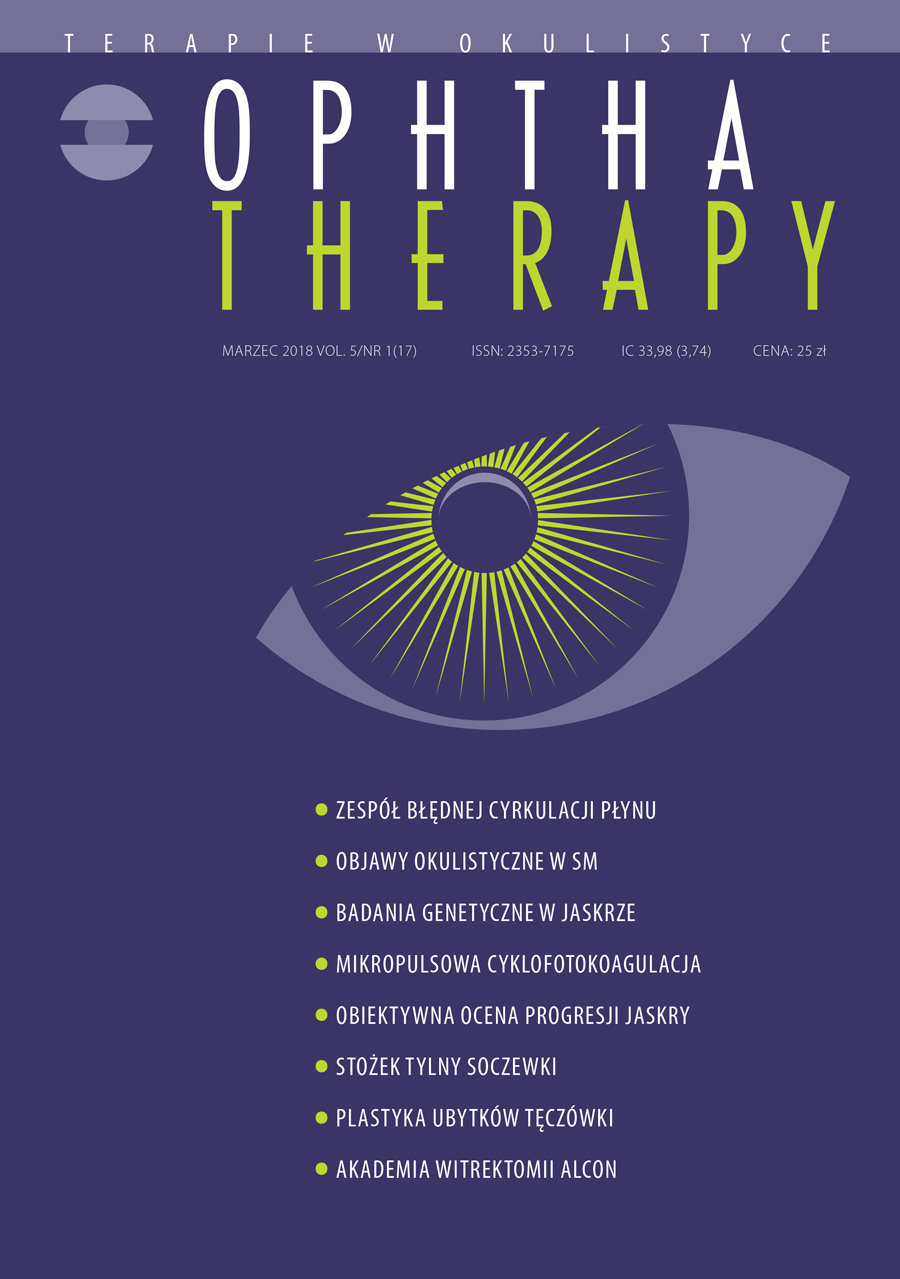Fluid misdirection syndrome – pathophysiology and treatment
Main Article Content
Abstract
Acute fluid misdirection syndrome is characterized by a very shallow anterior chamber with the absence of suprachoroidal effusion or hemorrhage and no noticeable pathology of the iris-lens diaphragm. It usually occurs during uneventful phacoemulsification, particularly in hyperopic eyes, as a result of inappropriate movement of balanced salt solution via the zonular fibers. This syndrome occurs from hours to months, or years, after the initial surgery. The pathophysiology of malignant glaucoma is based on a similar mechanism of aqueous outflow interference, therefore we suggest the term chronic fluid misdirection syndrome.
Downloads
Article Details

This work is licensed under a Creative Commons Attribution-NonCommercial-NoDerivatives 4.0 International License.
Copyright: © Medical Education sp. z o.o. License allowing third parties to copy and redistribute the material in any medium or format and to remix, transform, and build upon the material, provided the original work is properly cited and states its license.
Address reprint requests to: Medical Education, Marcin Kuźma (marcin.kuzma@mededu.pl)
References
2. Olson RJ, Younger KM, Crandall AS et al. Subcapsular fluid entrapment in extracapsular cataract surgery. Ophthalmic Surg. 1994; 25(10): 688-9.
3. Lau OCF, Montfort JM, Sim BW et al. Acute intraoperative rock-hard eye syndrome and its management. J Cataract Refract Surg. 2014; 40(5): 799-804.
4. Mackool RJ, Sirota M. Infusion misdirection syndrome. J Cataract Refract Surg. 1993; 19(5): 671-2.
5. Grzybowski A, Prasad S. Acute aqueous misdirection syndrome: Pathophysiology and management. J Cataract Refract Surg. 2014; 40(12): 2167.
6. Little BC, Hitchings RA. Pseudophakic malignant glaucoma: Nd:YAG capsulotomy as a primary treatment. Eye. 1993; 7(Pt 1): 102-4.
7. Sharma A, Sii F, Shah P et al. Vitrectomy-phacoemulsification-vitrectomy for the management of aqueous misdirection syndromes in phakic eyes. Ophthalmology. 2006; 113(11): 1968-73.
8. Rękas M, Krix-Jachym K, Żarnowski T. Evaluation of the Effectiveness of Surgical Treatment of Malignant Glaucoma in Pseudophakic Eyes through Partial PPV with Establishment of Communication between the Anterior Chamber and the Vitreous Cavity. J Ophthalmol. 2015; 2015: 873124.
9. Debrouwere V, Stalmans P, Van Calster J et al. Outcomes of different management options for malignant glaucoma: a retrospective study. Graefes Arch Clin Exp Ophthalmol. 2012; 250: 131-41.
10. Mastropasqua L, Ciancaglini M, Carpineto P et al. Aqueous misdirection syndrome: a complication of neodymium: YAG posterior capsulotomy. J Cataract Refract Surg. 1994; 20(5): 563-5.
11. Massicotte EC, Schuman JS. A malignant glaucoma-like syndrome following pars plana vitrectomy. Ophthalmology. 1999; 106(7): 1375-9.
12. Francis BA, Babel D. Malignant glaucoma (aqueous misdirection) after pars plana vitrectomy. Ophthalmology. 2000; 107(7): 1220-2.
13. Zacharia PT, Abboud EB. Recalcitrant malignant glaucoma following pars plana vitrectomy, scleral buckle, and extracapsular cataract extraction with posterior chamber intraocular lens implantation. Ophthalmic Surg Lasers. 1998; 29(4): 323-37.
14. Zarnowski T, Rękas M. Efficacy and safety of a new surgical method to treat malignant glaucoma in pseudophakia: reply. Eye. 2014; 28(11): 1391-2.
15. Prata TS, Dorairaj S, De Moraes CG et al. Is preoperative ciliary body and iris anatomical configuration a predictor of malignant glaucoma development? Clin Experiment Ophthalmol. 2013; 41(6): 541-5.
16. Premsenthil M, Salowi MA, Siew CM et al. Spontaneous malignant glaucoma in a patient with patent peripheral iridotomy. BMC Ophthalmol. 2012; 12: 64.
17. Quigley HA, Friedman DS, Congdon NG. Possible Mechanisms of Primary Angle-Closure and Malignant Glaucoma. J Glaucoma. 2003; 12(2): 167-80.
18. Tomey KF, Senft SH, Antonios SR et al. Aqueous misdirection and flat chamber after posterior chamber implants with and without trabeculectomy. Arch Ophthalmol. 1987; 105(6): 770-3.
19. Dave P, Senthil S, Rao HL et al. Treatment outcomes in malignant glaucoma. Ophthalmology. 2013; 120(5): 984-90.
20. Scott AS, Smith VH. Retrolental decompression for malignant glaucoma. Br J Ophthalmol. 1961; 45(10): 654-61.
21. Pasaoglu IB, Altan C, Bayraktar S et al. Surgical Management of Pseudophakic Malignant Glaucoma via Anterior Segment-Peripheral Iridectomy Capsulo-Hyaloidectomy and Anterior Vitrectomy. Case Rep Ophthalmol Med. 2012; 2012: 794938. https://doi.org/10.1155/2012/794938.
22. Madgula IM, Anand N. Long-term follow-up of zonulo-hyaloido-vitrectomy for pseudophakic malignant glaucoma. Indian J Ophthalmol. 2014; 62(12): 1115-20.
23. Lois N, Wong D, Groenewald C. New surgical approach in the management of pseudophakic malignant glaucoma. Ophthalmology. 2001; 108(4): 780-83.
24. Saunders PP, Douglas GR, Feldman F et al. Bilateral malignant glaucoma. Can J Ophthalmol. 1992; 27(2): 19-21.

